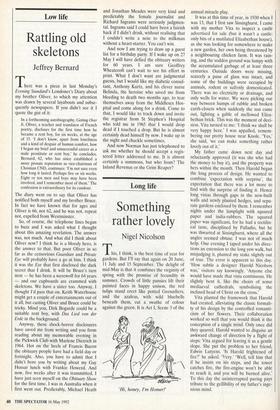Long life
Something
rather lovely
Nigel Nicolson
This, I think, is the best time of year for gardens. But I'll say that again on 20 June, 11 July and 15 September. The delight of mid-May is that it combines the virginity of spring with the promise of fecundity in summer. Crowds of little pansies lift their painted faces in happy unison, the red tulips stand erect like potted Grenadiers, and the azaleas, with wild bluebells beneath them, cut a swathe of colour against the green. It is Act I, Scene 3 of the
'Hi, honey, I'm Homer!' annual miracle play.
It was at this time of year, in 1930 when I was 13, that I first saw Sissinghurst. I came with my mother Vita to inspect a castle advertised for sale (but it wasn't a castle: only bits of a mutilated Elizabethan house), as she was looking for somewhere to make a new garden, her own being threatened by a neighbouring chicken farm. It was rain- ing, and the sodden ground was lumpy with the accumulated garbage of at least three centuries. Outside doors were missing, scarcely a pane of glass was intact, and some of the buildings were occupied by animals, rodent or sullenly domesticated. There was no electricity or drainage, and only wells for water. We were picking our way between humps of rubble and broken earth-closets when suddenly the sun came out, lighting a gable of mellowed Eliza- bethan brick. This was the moment of deci- sion. Vita turned to me: 'I think we shall be very happy here.' I was appalled, remem- bering our pretty house near Knole. 'Yes,' she said, 'we can make something rather lovely out of it.'
My father came down next day and reluctantly approved (it was she who had the money to buy it), and the property was hers within the month. Then Harold began the long process of design. He wanted to combine 'expectation with surprise', the expectation that there was a lot more to find with the surprise of finding it. Hence long vistas through gaps in the new-built walls and newly planted hedges, and sepa- rate gardens enclosed by them. I remember nights under the lamplight with squared paper and india-rubbers. The squared paper was significant, for he had a rectilin- eal taste, disciplined by Palladio, but he was thwarted at Sissinghurst, where all the angles seemed obtuse. I was not of much help. One evening I taped under his direc- tions an extension to the long yew walk, but misjudging it, planted my stake slightly out of true. The error is apparent to this day. 'How subtle a designer Harold Nicolson was,' visitors say knowingly. 'Anyone else would have made that vista continuous. He slightly bent it, like the choirs of some mediaeval cathedrals, symbolising the inclined head of Christ on the cross.'
Vita planted the framework that Harold had created, alleviating the classic formali- ty of his design by the controlled romanti- cism of her flowers. Their collaboration worked so well that you would think it the conception of a single mind. Only once did they quarrel. Harold wanted to disguise an awkward change of direction by a flight of steps: Vita argued for leaving it as a gentle slope. She put the problem to her friend, Edwin Lutyens. 'Is Harold frightened of fire?' he asked. 'Very."Well, tell him that if he insists on his steps, and the tower catches fire, the fire-engine won't be able to reach it, and you will be burned alive.'
To this day the uninterrupted paving pays tribute to the gullibility of my father's inge- nious mind.


















































 Previous page
Previous page